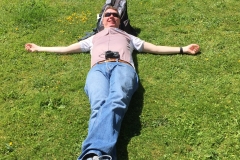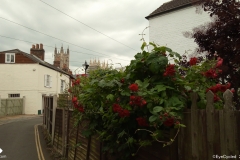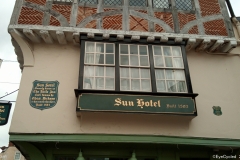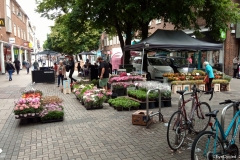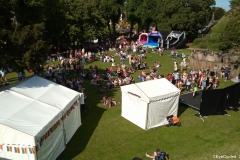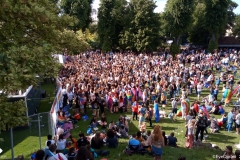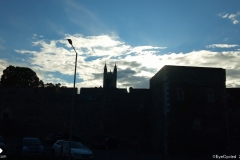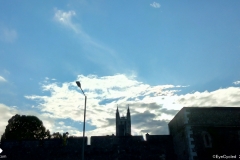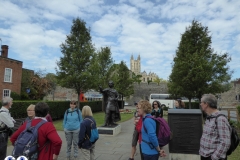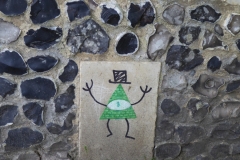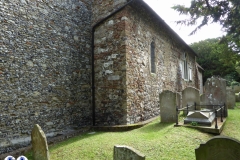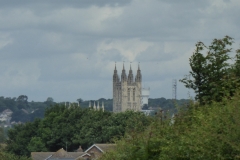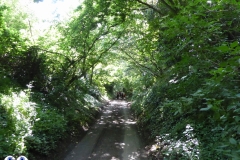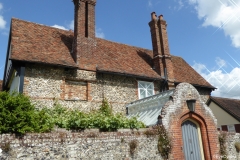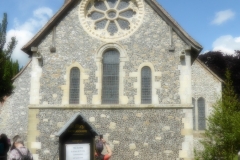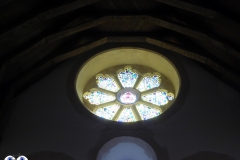EyeWalked?

Yes, I know… you thought EyeCycled.com was only about cycling. Well, you are not wrong. This is an exception. Hopefully an interesting one. Still, if you only want to see cycling material on EyeCycled.com, then look at this post I wrote (opens in separate tab) when I cycled from Canterbury to Dover on the regional cycling route 16 on the 8th of June 2016.
On the 14th of June 2019 I drove to Canterbury to attend the Pilgrims Workshop. The workshop was one of the events organized by the Confraternity of Pilgrims to Rome as part of the Canterbury Pilgrims Festival which happened between the 12th and the 15th of June.
While the workshop was great with some great presentations given by pilgrims who walked the Via Francigena and other routes, as well as insights into historical aspect of pilgrimage in Kent, this post is about the walking pilgrimage between Canterbury and Shepherdswell that happened on the 15th.
I will not write much here though… I will let the pictures do the talking…
IF…
… after seeing the pictures you are interested in knowing more about the historical significance of what you saw, I have added a number of online links below that you can visit to understand.
Enjoy!
- The Pictures of the walk
- The route and metrics
- Want to know more?
- Video of the group walking the path
- The Pilgrims Feast (after the walk)
The route and metrics
OK, there is a little part missing at the beginning, something like 1.3 Km, as I forgot to turn the tracking on when we left the cathedral. Adding this distance to the 23 Km tracked below you should expect to have to walk around 24 Km if you follow this route.
Want to know more?
The table below provides links where you can find out about the places in the picture above (may be updated after published).
| Link | Short Description |
|---|---|
| Wikipedia page about Canterbury | The Canterbury area has been inhabited since prehistoric times. Lower Paleolithic axes, and Neolithic and Bronze Age pots have been found in the area. Canterbury was first recorded as the main settlement of the Celtic tribe of the Cantiaci, which inhabited most of modern-day Kent. In the 1st century AD, the Romans captured the settlement and named it Durovernum Cantiacorum. The Romans rebuilt the city, with new streets in a grid pattern, a theatre, a temple, a forum, and public baths. Although they did not maintain a major military garrison, its position on Watling Street relative to the major Kentish ports of Rutupiae (Richborough), Dubrae (Dover), and Lemanae (Lymne) gave it considerable strategic importance. In the late 3rd century, to defend against attack from barbarians, the Romans built an earth bank around the city and a wall with seven gates, which enclosed an area of 130 acres (53 ha).... |
| Visit Canterbury Site | Things to do in Canterbury, places to stay, shopping, events, food & drink, etc. |
| Wikipedia page about the Canterbury Cathedral | Canterbury Cathedral is one of the oldest and most famous Christian structures in England. It forms part of a World Heritage Site. It is the cathedral of the Archbishop of Canterbury, leader of the Church of England and symbolic leader of the worldwide Anglican Communion. Its formal title is the Cathedral and Metropolitical Church of Christ at Canterbury. Founded in 597, the cathedral was completely rebuilt between 1070 and 1077. The east end was greatly enlarged at the beginning of the 12th century, and largely rebuilt in the Gothic style following a fire in 1174, with significant eastward extensions to accommodate the flow of pilgrims visiting the shrine of Thomas Becket, the archbishop who was murdered in the cathedral in 1170. The Norman nave and transepts survived until the late 14th century, when they were demolished to make way for the present structures. |
| Wikipedia page about St Augustine's Abbey. | St Augustine's Abbey was a Benedictine monastery. The abbey was founded in 598 and functioned as a monastery until its dissolution in 1538 during the English Reformation. After the abbey's dissolution, it underwent dismantlement until 1848. Since 1848, part of the site has been used for educational purposes and the abbey ruins have been preserved for their historical value. |
| Wikipedia page about the St Martin's Church, Canterbury | St Martin's was the private chapel of Queen Bertha of Kent in the 6th century before Augustine arrived from Rome. Queen Bertha was a Christian Frankish princess who arrived in England with her Chaplain, Bishop Liudhard. King Æthelberht of Kent, her pagan husband, allowed her to continue to practise her religion by renovating (ca. AD 580) an existing church which the Venerable Bede says had been in use in the late Roman period but had fallen into disuse. As Bede specifically names it, this church was dedicated to Saint Martin of Tours, a city located near where Bertha grew up. |
| Wikipedia page about Patrixbourne | Patrixbourne is a rural English village south-east of Canterbury in Kent, mostly taken up by agricultural hills. Along with almost contiguous Bekesbourne to the north it makes up the civil parish of Bekesbourne-with-Patrixbourne in the City of Canterbury district |
| Patrixbourne, St Mary's Church | The village of Patrixbourne lies on the route of the Pilgrims Way, the trail that led untold thousands of weary medieval feet towards Canterbury Cathedral and the shrine of Thomas Becket. But the villge long predates the arrival of the pilgrims; at the time of the Domesday Book in 1086 there was a church and four mills in the village, then called 'Born'. The manor was in the hands of a Norman lord called Richard Patric, whose family came from the Calvados region of France. |
| Wikipedia page about Womenswold | Historically, Womenswold has been recorded with various spellings, including Wymynswold[2] and Wimlingswold.[3] A further one may be Wymelyngewolde [4] The church of St, Margaret of Antioch covers all three hamlets, in Womenswold proper rather than the woodland, cereal and pasture fields within its bounds. A small mediaeval building without any side aisles, it is part of the Barham Downs group of churches. |
| The church building is unusual, in having no side aisles and a large Chancel, where services are usually held on the comfortable chairs that were installed in place of Victorian choir stalls. | |
| Wikipedia page about Shepherdswell | Village social life centres on the local Grade I listed church 'Church of St Andrew', and the village hall which is hosts events including charity jumble sales and a pre-school playgroup. The village pub is the Grade II listed Bell by the village green, near to the church |
| St Andrew's Church, Shepherdswell | St. Andrews Church occupies a site of continuing Christian worship since at least the Domesday Book, 1086. It was thought to have originally been a wooden Saxon Church that was replaced around the 12th century with the two-celled Romanesque church. |
Short Video of the group walking the path
Just 29 seconds (not in the YouTube channel)
The Pilgrims Feast (after the walk)
As you saw in the pictures above, we took the train back from Shepherdswell to Canterbury and the walked from the Canterbury East train station to the hall where the pilgrim’s feast was being celebrated. A celebration of medieval music, dances and food. It was good to be able to rest our tired feet, meet other like minded people, fill our bellies with delicious food and have fun.
You’ll find here a few pictures and some videos recorded during the pilgrims feast (none of them are in the YouTube channel).
If you have any questions, don’t hesitate to comment or send me a message through the contact form.
Please subscribe to my Blog and/or to my YouTube channel if you don’t want to miss the next one and help me spread the word by liking and sharing my Facebook Page and Tweeter feed also.
Thank you for your time!
Do you like these posts? Why, then, don’t you pay me a coffee to help with the blog hosting cost and as a caffeine incentive to keep me going through the long hours of the night? (Suggested amount: £2.00 or USD $3.00 or 2.50€ or whatever you want to give).
You may donate through my Patreon Page or through PayPal directly.


